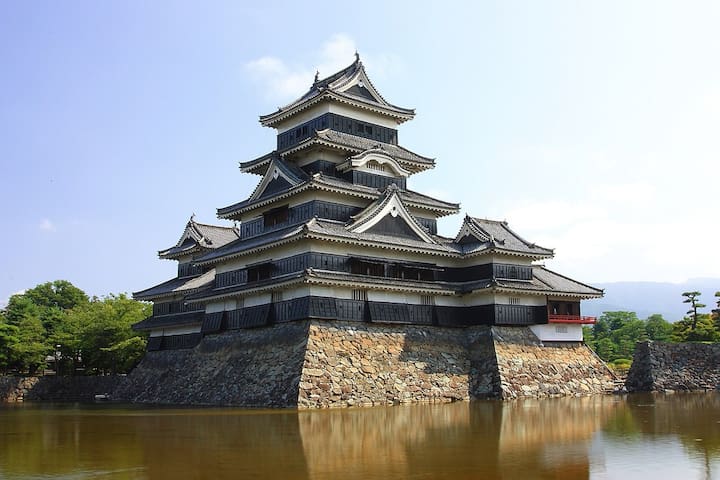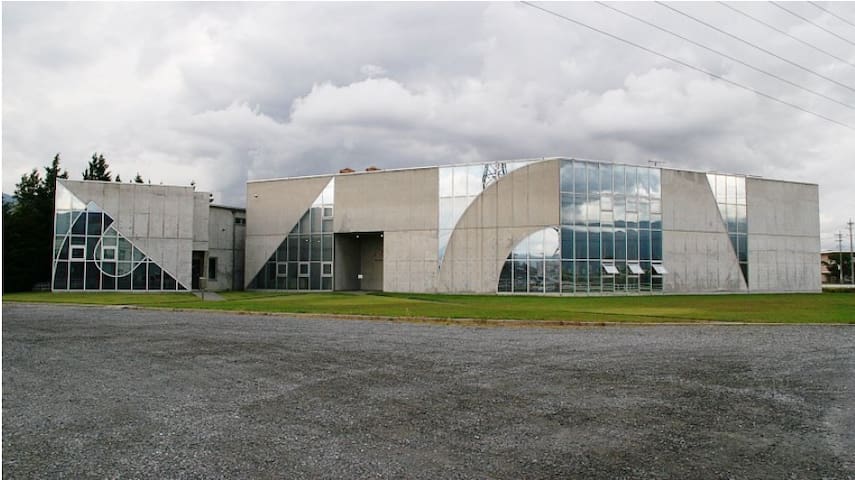観光
Matsumoto Castle (松本城, Matsumotojō) is one of the most complete and beautiful among Japan's original castles. It is a "hirajiro" - a castle built on plains rather than on a hill or mountain. Matsumoto Castle is unique for having both a secondary donjon and a turret adjoined to its main keep. The castle structures, in combination with their characteristic black wainscoting, give off an air of grandeur and poise.
Matsumotojo's main castle keep and its smaller, second donjon were built from 1592 to 1614. Both these structures were well-fortified as peace was not yet fully achieved at the time. In 1635, when military threats had ceased, a third, barely defended turret and another for moon viewing were added to the castle.
The wooden interior of Matsumoto Castle provides an authentic experience unlike that felt at many other castles rebuilt of ferro-concrete. Interesting features of the castle include steep wooden stairs, openings to drop stones onto invaders, openings for archers, as well as an observation deck at the top, sixth floor of the main keep with nice views over the surrounding city.
In spring, Matsumoto Castle is a popular cherry blossom spot. Many visit to stroll around the spacious castle grounds and park. Along the outer castle moat are hundreds of somei yoshino cherry trees that provide lovely views when they are in full bloom around mid April each year.
Access
The castle is a 15 minute walk or a 5 minute bus ride on the "Town Sneaker" Northern Course bus loop line from JR Matsumoto Station.
36 lokal ang nagrerekomenda
Kastilyong Matsumoto
4-1 MarunouchiMatsumoto Castle (松本城, Matsumotojō) is one of the most complete and beautiful among Japan's original castles. It is a "hirajiro" - a castle built on plains rather than on a hill or mountain. Matsumoto Castle is unique for having both a secondary donjon and a turret adjoined to its main keep. The castle structures, in combination with their characteristic black wainscoting, give off an air of grandeur and poise.
Matsumotojo's main castle keep and its smaller, second donjon were built from 1592 to 1614. Both these structures were well-fortified as peace was not yet fully achieved at the time. In 1635, when military threats had ceased, a third, barely defended turret and another for moon viewing were added to the castle.
The wooden interior of Matsumoto Castle provides an authentic experience unlike that felt at many other castles rebuilt of ferro-concrete. Interesting features of the castle include steep wooden stairs, openings to drop stones onto invaders, openings for archers, as well as an observation deck at the top, sixth floor of the main keep with nice views over the surrounding city.
In spring, Matsumoto Castle is a popular cherry blossom spot. Many visit to stroll around the spacious castle grounds and park. Along the outer castle moat are hundreds of somei yoshino cherry trees that provide lovely views when they are in full bloom around mid April each year.
Access
The castle is a 15 minute walk or a 5 minute bus ride on the "Town Sneaker" Northern Course bus loop line from JR Matsumoto Station.
The Matsumoto City Museum of Art (松本市美術館, Matsumoto-shi Bijutsukan) is a museum in Matsumoto dedicated to showcasing the work of artists associated with the city. The museum's main attraction is its collection of works from the world famous Matsumoto-born artist Kusama Yayoi. Kusama was born in 1929 and is internationally known for her hallmark bright and vivid pieces that include one of her most famous works, Pumpkin, on Naoshima Island in Kagawa Prefecture.
The collection of the artist's works exhibited at the Matsumoto City Museum of Art include various paintings and sculptures that were created in her typically vivid and colorful style. Yayoi's work is also exhibited outside the building's main entrance in the form of a large sculpture of tulips that was erected with the museum's founding in 2002. The works of other artists are showcased in a separate section of the museum with exhibits that rotate throughout the year. The museum also houses a shop selling various souvenirs and goods relating to the art.
Matsumoto City Museum of Art
4-chōme-2-22 ChūōThe Matsumoto City Museum of Art (松本市美術館, Matsumoto-shi Bijutsukan) is a museum in Matsumoto dedicated to showcasing the work of artists associated with the city. The museum's main attraction is its collection of works from the world famous Matsumoto-born artist Kusama Yayoi. Kusama was born in 1929 and is internationally known for her hallmark bright and vivid pieces that include one of her most famous works, Pumpkin, on Naoshima Island in Kagawa Prefecture.
The collection of the artist's works exhibited at the Matsumoto City Museum of Art include various paintings and sculptures that were created in her typically vivid and colorful style. Yayoi's work is also exhibited outside the building's main entrance in the form of a large sculpture of tulips that was erected with the museum's founding in 2002. The works of other artists are showcased in a separate section of the museum with exhibits that rotate throughout the year. The museum also houses a shop selling various souvenirs and goods relating to the art.
The Japan Ukiyoe Museum (日本浮世絵博物館, Nihon Ukiyoe Hakubutsukan) exhibits ukiyoe (woodblock prints) from the vast collection of the Sakai family. One of Matsumoto's wealthiest merchants of his time, Sakai Yoshiaki started collecting ukiyoe and other pieces of art roughly 300 years ago. His descendants have been enlarging the collection to over 100,000 pieces, making it one of the world's largest private art collections.
Compared to the size of the collection and the museum building, the number of works exhibited in the Japan Ukiyoe Museum is rather small, partly due to the fact that the building was originally built solely for storage rather than exhibition purposes. English descriptions for the exhibits are brief.
Japan Ukiyo-e Museum
2206-1 島立小柴The Japan Ukiyoe Museum (日本浮世絵博物館, Nihon Ukiyoe Hakubutsukan) exhibits ukiyoe (woodblock prints) from the vast collection of the Sakai family. One of Matsumoto's wealthiest merchants of his time, Sakai Yoshiaki started collecting ukiyoe and other pieces of art roughly 300 years ago. His descendants have been enlarging the collection to over 100,000 pieces, making it one of the world's largest private art collections.
Compared to the size of the collection and the museum building, the number of works exhibited in the Japan Ukiyoe Museum is rather small, partly due to the fact that the building was originally built solely for storage rather than exhibition purposes. English descriptions for the exhibits are brief.
The Matsumoto Timepiece Museum (松本市時計博物館, Matsumoto-shi Tokei Hakubutsukan) is a museum in Matsumoto dedicated to timepieces from inside and outside of Japan. The museum, which is spread over three floors, showcases watches and clocks of many different kinds. Exhibits include watches linked to certain professions, such as train conductor and nurse watches, and ornate timepieces from different countries, like European and Asian grandfather clocks from past centuries. There are also various clocks with quirky design elements and even sundials.
While the first two floors house the museum's permanent collection, which also includes a small exhibition of gramophones and musical records, the third floor holds temporary exhibitions of clocks connected through a particular theme. A symbol of the museum and embedded on its outside wall is the largest pendulum clock in Japan.
Matsumoto City Timepiece Museum
1-chōme-21-15 ChūōThe Matsumoto Timepiece Museum (松本市時計博物館, Matsumoto-shi Tokei Hakubutsukan) is a museum in Matsumoto dedicated to timepieces from inside and outside of Japan. The museum, which is spread over three floors, showcases watches and clocks of many different kinds. Exhibits include watches linked to certain professions, such as train conductor and nurse watches, and ornate timepieces from different countries, like European and Asian grandfather clocks from past centuries. There are also various clocks with quirky design elements and even sundials.
While the first two floors house the museum's permanent collection, which also includes a small exhibition of gramophones and musical records, the third floor holds temporary exhibitions of clocks connected through a particular theme. A symbol of the museum and embedded on its outside wall is the largest pendulum clock in Japan.




